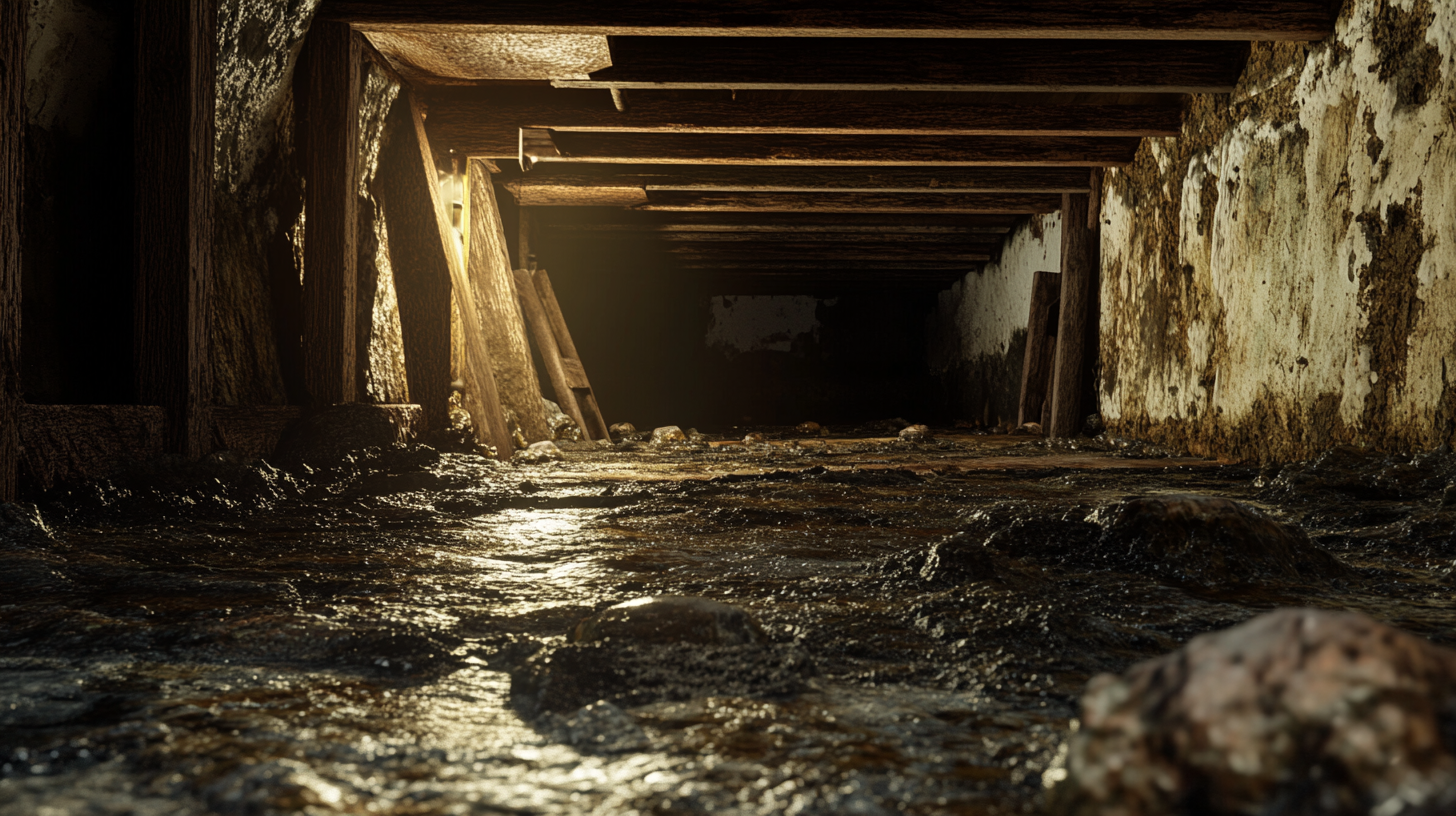Now IS THe Time To...

Crawl Space Services In Knoxville, TN
Stetson Howard: 865-432-6743
CRAWL SPACE ENCAPSULATION, REPAIR, WATERPROOFING & MOLD REMOVAL
No-Obligation, Free Inspections
No-Obligation Free Estimates
We Warranty All of Our Work
100% Satisfaction Guaranteed
Welcome to our comprehensive exploration of the often-overlooked connection between waterproofing and pest control in building maintenance. This blog delves into how these two crucial aspects of property care are interlinked and why addressing both is essential for the overall integrity and health of any building.
Fortifying Foundations Against Water and Unwanted Guests
Waterproofing and pest control are two sides of the same coin when it comes to protecting a building. While waterproofing guards against water damage, it also plays a significant role in pest prevention. Conversely, effective pest control measures can contribute to maintaining the integrity of a building's waterproofing systems.
The Critical Intersection of Waterproofing and Pest Control
Water Intrusion: A Gateway for Pests: Moisture is a major attractant for many pests, including insects and rodents. Waterproofing failures can lead to damp conditions that create ideal breeding grounds for pests, leading to infestations that can compromise both the health of the building's occupants and the structure itself.
Pest Infestations: Compromising Waterproofing Integrity: Pests such as termites and rodents can cause significant damage to waterproofing materials, leading to leaks and further moisture problems. This creates a vicious cycle where water damage facilitates pest invasion, and pests, in turn, exacerbate water damage issues.
In this blog, we will explore the synergistic relationship between waterproofing and pest control. We aim to provide insights into how a comprehensive approach to both can prevent structural damage, enhance the longevity of the building, and ensure a healthier living environment. From understanding the common points of entry for pests and moisture to implementing integrated strategies that address both issues, we will cover the essential steps to safeguard your building against these twin threats.
Join us as we navigate the intertwined paths of waterproofing and pest control, highlighting their importance in building maintenance and the
benefits of a holistic approach to protecting your property.
Understanding the Connection Between Moisture and Pests
The relationship between moisture and pests is a critical aspect of building maintenance and health. Moist environments can attract a variety of pests, each posing unique risks. Understanding this connection is key to implementing effective waterproofing and pest control strategies.
Attracting Pests with Moist Environments
Explanation of How Moisture Attracts Various Pests
- Moisture creates an ideal environment for many pests, serving as a necessary resource for their survival. High humidity levels and damp conditions provide the perfect breeding ground for pests like termites, carpenter ants, cockroaches, and rodents.
- These pests are not only attracted to the moisture itself but also to the softened wood, mold, and fungi that thrive in these wet conditions. This makes moist areas in buildings particularly vulnerable to infestations.
Types of Pests Commonly Found in Damp Areas
- Termites and Carpenter Ants: These insects are particularly drawn to moist wood, which is easier for them to chew through. They can cause significant structural damage over time.
- Cockroaches and Silverfish: These pests thrive in humid environments and are often found in basements, bathrooms, and kitchens where moisture levels are higher.
- Rodents: Mice and rats seek out damp areas for nesting. They can chew through waterproofing materials, exacerbating moisture problems and leading to further infestations.
Health Risks Associated with Moisture and Pests
Health Hazards Posed by Pests in Moist Environments
- Pests in moist environments can pose several health risks. Rodents and cockroaches, for instance, are known to carry diseases and can contaminate food sources. The presence of pests can also exacerbate allergies and asthma, particularly in damp conditions where mold and mildew are present.
- Additionally, the structural damage caused by pests like termites can create unsafe living conditions, with the potential for weakened structures leading to accidents.
The Role of Waterproofing in Mitigating These Risks
- Effective waterproofing is a crucial step in mitigating the risks posed by moisture and pests. By preventing water ingress and controlling humidity levels within a building, waterproofing reduces the likelihood of pest infestations.
- Regular inspections and maintenance of waterproofing systems can help identify potential problem areas before they become serious. This includes checking for leaks, ensuring proper drainage, and repairing any damage to waterproofing barriers.
Key Areas Where Waterproofing Aids Pest Control
Effective waterproofing plays a crucial role in pest control, particularly in certain areas of a building that are more prone to moisture and, consequently, pest infestations. This section will focus on how waterproofing can be a vital tool in managing pest issues in basements, crawl spaces, walls, and attics.
Basements and Crawl Spaces
Common Pest Issues in These Areas
Basements and crawl spaces are often hotspots for pests due to their high humidity levels and proximity to the ground. Common pests in these areas include termites, carpenter ants, rodents, and various types of insects. These pests are attracted to the damp conditions and can cause significant damage to the structure and foundation of the building.
Waterproofing Methods to Prevent Pest Infestation
- Implementing waterproofing measures is key to controlling moisture and deterring pests in basements and crawl spaces. This can include the application of waterproof coatings or sealants on walls and floors, installation of vapor barriers, and ensuring proper drainage around the foundation.
- Sump pump systems and dehumidifiers can also be effective in managing moisture levels in these areas. Regular maintenance and inspections of these systems are crucial to ensure they remain effective in keeping the space dry and less attractive to pests.
Walls and Attics
How Moisture in Walls and Attics Attracts Pests
- Moisture accumulation in walls and attics can arise from leaks, poor ventilation, or condensation issues. This moisture creates an ideal environment for pests such as termites, ants, and rodents, as well as mold and mildew, which can further attract insects.
- Pests in these areas can go unnoticed for long periods, causing significant damage to insulation, electrical wiring, and wooden structures. This can lead to costly repairs and potential health hazards.
Waterproofing Solutions for These Areas
- In walls, effective waterproofing solutions include the use of moisture-resistant materials during construction, sealing any cracks or openings, and ensuring that exterior cladding is properly installed and maintained.
- For attics, proper roof maintenance to prevent leaks is essential. Additionally, ensuring adequate ventilation can help control moisture levels. This might involve installing ridge vents, soffit vents, or attic fans to promote air circulation and reduce condensation.
- Regular inspections of these areas for signs of moisture or pest activity can help catch problems early, before they escalate into more serious issues.
Waterproofing Materials and Pest Deterrence
The choice of waterproofing materials can significantly impact a building's susceptibility to pest infestations. Certain materials not only provide a barrier against moisture but also act as deterrents to pests. This section will explore materials that serve both purposes and the use of sealants and barriers for enhanced protection.
Choosing Pest-Resistant Materials
Introduction of Waterproofing Materials That Also Deter Pests
- Some waterproofing materials are inherently resistant to pests. For instance, certain types of concrete treatments and membranes are less appealing to pests like termites and rodents due to their composition and texture.
- Metal flashing and mesh, often used in waterproofing, can also act as physical barriers to pests. These materials are too tough for pests like rodents to chew through, effectively keeping them out of protected areas.
Benefits of Using Such Materials in Pest-Prone Areas
- Using pest-resistant waterproofing materials offers a dual benefit. Firstly, it provides long-lasting moisture protection, crucial for the structural integrity of the building. Secondly, it reduces the likelihood of pest infestations, which can lead to damage and health hazards.
- In areas prone to specific pests, such as termites in wood structures or rodents in urban settings, these materials can be particularly beneficial. They provide an added layer of security, reducing the need for frequent pest control treatments.
Sealants and Barriers
Types of Sealants and Barriers Effective Against Both Moisture and Pests
- Sealants like silicone or polyurethane are effective in sealing cracks and gaps where moisture and pests might enter. Some sealants are infused with pesticides or natural deterrents, providing an additional layer of pest protection.
- Physical barriers, such as copper or stainless steel mesh, can be installed in potential entry points for pests. These are especially effective in areas like vents, where they prevent pests from entering while still allowing moisture to escape.
Application Tips for Maximum Effectiveness
- When applying sealants, ensure that the surface is clean and dry for optimal adhesion. Apply the sealant evenly, filling all cracks and crevices where pests might enter.
- For physical barriers, proper installation is key. Ensure that the barriers are securely attached and cover the entire area of potential entry. In the case of mesh, it should be fine enough to prevent pests from passing through but not so dense as to restrict air flow or moisture escape.
- Regular inspections and maintenance of these barriers and sealants are important to ensure they continue to provide effective protection against both moisture and pests.
Integrated Pest Management and Waterproofing
Integrated Pest Management (IPM) is a comprehensive approach to pest control that emphasizes the use of multiple strategies in a coordinated effort. Waterproofing plays a crucial role in this approach, acting as a preventive measure against pest infestations. This section will explore how waterproofing integrates into IPM and can be combined with other pest control measures for enhanced effectiveness.
Principles of Integrated Pest Management (IPM)
Introduction to IPM and Its Relevance to Waterproofing
- Integrated Pest Management (IPM) is a holistic approach to pest control that focuses on long-term prevention and management, using a combination of techniques that are environmentally sensitive and effective. IPM involves understanding the lifecycle of pests and their interaction with the environment.
- Waterproofing is a key component of IPM as it addresses one of the primary attractants for pests: moisture. By eliminating sources of moisture through effective waterproofing, the likelihood of pest infestations can be significantly reduced.
How Waterproofing Fits into an IPM Strategy
- In the context of IPM, waterproofing is a proactive measure to create an environment that is less conducive to pests. It serves as a physical barrier, preventing pests from accessing the building through moisture-prone areas.
- Waterproofing also complements other IPM strategies such as habitat modification, exclusion techniques, and the judicious use of pesticides. By reducing moisture, waterproofing can enhance the effectiveness of these other methods.
Combining Waterproofing with Other Pest Control Measures
Synergistic Effects of Waterproofing and Traditional Pest Control Methods
- When combined with traditional pest control methods, waterproofing can lead to a synergistic effect, enhancing the overall pest management strategy. For example, while baits and traps can manage existing infestations, waterproofing can prevent new infestations by removing the conditions that attract pests.
- This integrated approach not only helps in managing current pest issues but also in preventing future problems, leading to a more sustainable and long-term solution.
Case Studies or Examples of Successful Integration
- A case study might involve a residential building that struggled with recurring termite infestations. The implementation of a comprehensive waterproofing plan, along with targeted pesticide treatments, resulted in a significant reduction in termite activity.
- Another example could be a commercial facility where the integration of waterproofing measures, along with improved sanitation practices and mechanical barriers, effectively controlled a rodent problem that was previously persistent.
Maintenance Tips for Long-Term Protection
Maintaining the integrity of a building's waterproofing and pest control systems is crucial for long-term protection. Regular inspections, timely repairs, and understanding when to seek professional help are key components of effective maintenance. This section will provide insights into these aspects, ensuring your building remains secure and healthy.
Regular Inspections and Repairs
Importance of Regular Inspections for Both Waterproofing and Pest Control
- Regular inspections are vital in identifying potential problems before they escalate. For waterproofing, this means checking for leaks, cracks, or any signs of moisture intrusion. In terms of pest control, look for signs of infestation, such as droppings, nests, or damage to structures.
- Seasonal changes often bring new challenges for both waterproofing and pest control. Therefore, inspections should be scheduled accordingly, typically in the spring and fall, to prepare for the more extreme conditions of summer and winter.
Identifying and Addressing Potential Issues Early
- Early identification of issues allows for timely intervention, which can significantly reduce repair costs and prevent extensive damage. For waterproofing, address any signs of dampness or water damage immediately. In pest control, early signs of infestation should prompt quick action to prevent the problem from spreading.
- Keep a maintenance log to track any changes or repairs. This can be invaluable in understanding the long-term needs of your building and planning for future maintenance.
DIY Maintenance vs. Professional Services
When to Handle Maintenance Yourself and When to Call Professionals
- Simple maintenance tasks like clearing gutters, applying sealant to small cracks, or setting up basic pest traps can often be handled DIY. However, if you encounter complex issues, such as major leaks, structural damage, or a large-scale pest infestation, it's time to call in the professionals.
- Regular professional inspections can also be beneficial, as experts may identify issues that are not immediately apparent to the untrained eye.
Tips for Choosing a Reputable Waterproofing and Pest Control Service
- Research and choose services with good reputations and proper certifications. Look for reviews, ask for references, and check their standing with professional associations.
- Ensure that the service providers offer a warranty or guarantee on their work. This not only provides peace of mind but also indicates their confidence in the quality of their service.
- Don’t hesitate to ask questions about their approach and the materials they use. A reputable service provider will be transparent and willing to explain their process and the rationale behind it.
FAQs
Recent Blog Posts
Crawl Space News







